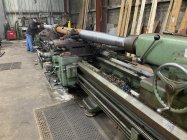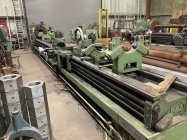What airplane have u seen with a lathe installed on it? Never seen one in a 40 year aviation career.But what about lathes on planes? How do G forces affect taper?
Install the app
How to install the app on iOS
Follow along with the video below to see how to install our site as a web app on your home screen.
Note: This feature may not be available in some browsers.
You are using an out of date browser. It may not display this or other websites correctly.
You should upgrade or use an alternative browser.
You should upgrade or use an alternative browser.
Leveling a Lathe the Easy Way
- Thread starter INTJ
- Start date
TylerFromMS
Gold $$ Contributor
That's amazing. Thanks for sharing. It's sort of mind blowing how something so big has tolerances so small.This came in on a 40’ truck. We hire a professional machinery mover to unload the machine and put it in place.
They use huge fork trucks, and work like a fine choreographed team.
We set it on steel pads and level it.
Dusty Stevens
Shiner
In flight repairs?What airplane have u seen with a lathe installed on it? Never seen one in a 40 year aviation career.
What airplane have u seen with a lathe installed on it? Never seen one in a 40 year aviation career.
I just can't think of a way to respond without sounding mean, so I'll just let this one go........
We need that picture. A guy out on the wing working on something.In flight repairs?
What are you using to span the ways there?As you can see in the pictures I posted, we use a precision level across ways at each foot to get the twist out.
The issue I ran into is that my lathes have a flat way in the rear and a v in front. It was just easier to stone the burs off the top of the carriage and place the level on it. Then move the entire carriage back and forth with the level on it.
We had an old South Bend something or other at work. The tailstock end of the bed was attached to the foot with what looked like a single pivot bolt. I don't think you could have twisted that bed if you tried.
That "Pivot Bolt" is actually two (one on each side) with a mechanism in the middle that applies force to the bedway in opposite directions (kinda like offsetting your tailstock). Loosen one and tighten the other and you end up with an ever so slight force on the bedway that makes it twist with respect to the headstock end. You may have noticed that there are lock-nuts as well. Once you get it where you want it, you lock it down.
jackieschmidt
Gold $$ Contributor
We have a 32’ Lehmann Lathe that has one way higher than the other, The book says it is exactly 3/8 inch. So we take our flat bar at just use a 3/8 spacer under one side.What are you using to span the ways there?
The issue I ran into is that my lathes have a flat way in the rear and a v in front. It was just easier to stone the burs off the top of the carriage and place the level on it. Then move the entire carriage back and forth with the level on it.
This big American has ways that are the same Height. We have a piece of ground flat bar that we lay across the top of the ways to place the level on.
 It came with the lathe.
It came with the lathe.Here is a picture this morning of one of my men roughing outs 35’ long 9 inch piece getting it ready for the Stainless Steel submerged arc welding.
Last edited:
jackieschmidt
Gold $$ Contributor
Interesting and not at all what I thought it was. I'll have to look closer if I ever see the machine again.That "Pivot Bolt" is actually two (one on each side) with a mechanism in the middle that applies force to the bedway in opposite directions (kinda like offsetting your tailstock). Loosen one and tighten the other and you end up with an ever so slight force on the bedway that makes it twist with respect to the headstock end. You may have noticed that there are lock-nuts as well. Once you get it where you want it, you lock it down.
LVLAaron
Gold $$ Contributor
So where is the post about leveling the easy way!! Which #?
I think it's "Let someone with a lot more experience do it for you"
More than capable, good response though.I think it's "Let someone with a lot more experience do it for you"
jackieschmidt
Gold $$ Contributor
We make those.You have some massive nuts there Jackie!
We make them because the ones you buy are junk.
I think it's "Let someone with a lot more experience do it for you"
Just in case it got missed somewhere in here.....
The "easy way" part is after you make an adjustment, let the lathe settle. It takes a few minutes for it to untwist and settle into the new adjustment.
The hard way is to continually adjust back and forth without pause until the lathe is level. Both methods take about the same amount of time. The easy way doesn't kill your back and knees.......
Thanks INTJ
Just in case it got missed somewhere in here.....
The "easy way" part is after you make an adjustment, let the lathe settle. It takes a few minutes for it to untwist and settle into the new adjustment.
The hard way is to continually adjust back and forth without pause until the lathe is level. Both methods take about the same amount of time. The easy way doesn't kill your back and knees.......
As said in your opening post, let the lathe bed relax between adjustments, makes sense & a practice I use on marine eq alignment. Likely also relevant for lathes that aren't fixed down.
jackieschmidt
Gold $$ Contributor
What sort of marine alignments are you involved with?Thanks INTJ
As said in your opening post, let the lathe bed relax between adjustments, makes sense & a practice I use on marine eq alignment. Likely also relevant for lathes that aren't fixed down.
Small boat-ship engine, shaft & pump. On & off the water.What sort of marine alignments are you involved with?
Similar threads
Upgrades & Donations
This Forum's expenses are primarily paid by member contributions. You can upgrade your Forum membership in seconds. Gold and Silver members get unlimited FREE classifieds for one year. Gold members can upload custom avatars.

Click Upgrade Membership Button ABOVE to get Gold or Silver Status.
You can also donate any amount, large or small, with the button below. Include your Forum Name in the PayPal Notes field.
To DONATE by CHECK, or make a recurring donation, CLICK HERE to learn how.

Click Upgrade Membership Button ABOVE to get Gold or Silver Status.
You can also donate any amount, large or small, with the button below. Include your Forum Name in the PayPal Notes field.
To DONATE by CHECK, or make a recurring donation, CLICK HERE to learn how.












